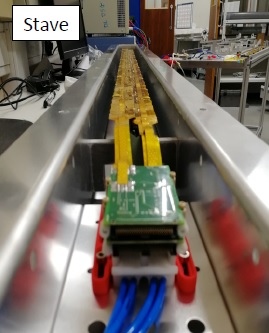 Picture of the new Inner Tracking System (ITS-2) for ALICE at CERNFunded by STFC, the nuclear physics groups at the University of Birmingham, the Daresbury Laboratory, and the University of Liverpool were significantly involved in the production of both the trigger and the inner tracking systems.
Picture of the new Inner Tracking System (ITS-2) for ALICE at CERNFunded by STFC, the nuclear physics groups at the University of Birmingham, the Daresbury Laboratory, and the University of Liverpool were significantly involved in the production of both the trigger and the inner tracking systems.
To fulfil the requirements of the physics program of the LHC Run 3, the ALICE Experiment at CERN needed a replacement of its Inner Tracking System (ITS-1). The new system, ITS-2, is a 7-layer pixel-only tracker made out of more than 24,000 monolithic active pixel sensor chips, named ALPIDE (Alice Pixel DEtector), arranged into modules positioned on staves.
Daresbury laboratory was one of 5 Stave construction sites worldwide, including Berkeley (US), Daresbury (UK), Frasca( (IT), Nikhef(NL), and Turin (IT).
Conceptual designs of the staves and components
 A closeup of a stave at Daresbury Laboratory
The expertise within STFC's Nuclear Physics, Detector Systems, Mechanical, Metrology and Technical Engineering, and Projects and Mechanical Engineering groups in project management, wire bonding of modules and precise assembly, was key to the production of staves at a high successful yield (95.5%). In 2019, the 22 individual staves built at Daresbury were delivered to CERN, where they were installed and commissioned in time for the start of LHC run 3.
A closeup of a stave at Daresbury Laboratory
The expertise within STFC's Nuclear Physics, Detector Systems, Mechanical, Metrology and Technical Engineering, and Projects and Mechanical Engineering groups in project management, wire bonding of modules and precise assembly, was key to the production of staves at a high successful yield (95.5%). In 2019, the 22 individual staves built at Daresbury were delivered to CERN, where they were installed and commissioned in time for the start of LHC run 3.
The assembly procedure is as follows:
-
Modules are aligned and glued to cold plate
-
Inter-module connection (soldering)
-
Functional and QA tests
-
Aligned and glued onto space-frame
-
Power bus connection
-
Functional and QA tests
-
Packed and shipped to CERN
Further information
Learn more about ALICE ITS-2:
https://indico.cern.ch/event/1210704/
https://ep-news.web.cern.ch/content/commissioning-and-installation-new-alice-its
Written by Marc Labiche, Nuclear Physics group leader.
